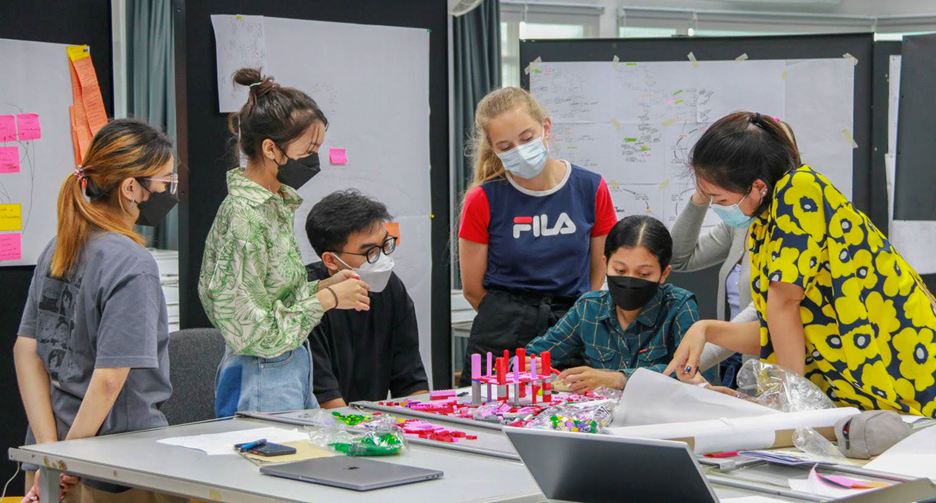| Supervisor(s) | Koen De Wandeler |
| Campus | BXL |
| Language | EN |
| Studio or individual? | individual |
| Max number of students? | 2 |
Description of the project: This master project critically examines the role of architects, designers and urban (ADU) professionals in their engagement with other stakeholders and with the practice of planning, designing, building, and managing health care as an integral part of the post-pandemic built environment. It mainly deals with aspects in the decarbonized, regenerative production and reproduction of inclusive health care facilities that positively affect the carrying capacity of the human habitat.
Eligbility & expected output
This master project is intended as a further reflection on the TU-KU Leuven-WHO-Téchne summer school conducted in July 2023. Therefore, candidates for this master project ideally would have participated in this summer school. Above all, they need to be familiar with ecological thinking launched in the 1970s and have previous interest and/or experience in sustainable architecture and design and/or initiatives that promote circular economy and/or inclusiveness. They should have a keen interest to delve into recent literature on system thinking, system design and system practice and produce an output that takes systems thinking as a thematic entry point.
Study trip? (+ timing): Selected participants will work in team with the academic promotor throughout their dissertation. In a first instance, they will work in team to familiarize themselves with systems thinking, design and practice. A write-up of that exercise will serve as literature review for their dissertation. Next, every student will be given the opportunity to register for a free online course in system practice and/or tie in as an observer with any of the electives, courses, design studios, summer schools, or workshops of the Faculty. Ideally, they should participate in the TU-KU Leuven-WHO-Téchne summer school conducted in July 2023.
References/Further reading:
Acumen Academy (n.d.). Systems Practice. An 8-week online training course. https://acumenacademy.org/course/systems-practice/
Adam, T., & de Savigny, D. (2012). Systems thinking for strengthening health systems in LMICs: need for a paradigm shift. Health Policy Plan, 27(Suppl 4), 1–3.
Barbero, S., & Pereno, A. (2020). Editorial: Relating Systems Thinking and Design. Systemic Design and Co-creation processes for Territorial Enhancement. Strategic Design Research Journal, 13(2).
https://doi: 10.4013/sdrj.2020.132.01
Caragliu, A., & Del Bo, C. F. (2019). Smart innovative cities: The impact of Smart City policies on urban innovation. Technological Forecasting and Social Change, 142, 373-383.
Dens, S., Nieto-Sanchez, C., De Los Santos, M., Hawer, T., Haile, A., Solari, K., Cisneros, J., Vega, V., Solomon, K., Addissie, A., Yewhalaw, D., Otero, L., Grietens K. P., Verdonck, K., & Van Acker, M. (2022). Drawings as tools to (re)imagine space in interdisciplinary global health research. Front. Public Health,10, 985430. https://doi.org/10.3389/fpubh.2022.985430
Hensel, M. U., Hensel, D. S., & Sevaldson, B. (2019). Editorial RSD5: Linking systems-thinking and design-thinking in architecture and urban design. FormAkademisk, 12(2). https://doi.org/10.7577/formakademisk.3406
Jones, P. (2014). Systemic Design Principles for Complex Social Systems. In G. Metcalf (Ed.), Social Systems and Design. Volume 1 of the Translational Systems Science Series (pp. 91-128). Springer Verlag. https://doi.org/10.1007/978-4-431-54478-4_4.
Jones, P., & Van Ael, K. (2022). Design Journeys through Complex Systems. Practice Tools for Systemic Design. BIS Publishers.
Khan, A. (2021). Thinking Tools for Systems Thinking, Technology. Architecture + Design, 5(2), 134-139. https://doi.org/10.1080/24751448.2021.1967051
Meadows, D. H., Meadows, D. L., Randers, J. Behrens III, W. W. (1972). The Limits to Growth: A Report for the Club of Rome’s Project on the Predicament of Mankind. Universe Books.
Meadows, D. H. (1999). Leverage Points: Places to Intervene in a System. The Sustainability Institute.
Meadows, D. H. (2008). Thinking in systems: a primer (D. Wright, Ed.). Chelsea Green Publishing.
Monat, J. P., & Gannon, T. F. (2015). What is systems thinking? A review of selected literature plus recommendations. American Journal of Systems Science, 4(1), 11-26.
Murphy, R., & Jones, P. (2020). Leverage analysis: A method for locating points of influence in systemic design decisions. FormAkademisk, 13(2). https://doi.org/10.7577/formakademisk.3384
Omidyar Group (2017). Systems Practice Workbook. Omidyar Group. https://docs.kumu.io/content/Workbook-012617.pdf
Peters, D. H. (2014). The application of systems thinking in health: why use systems thinking? Health Research Policy and Systems, 12(51). http://www.health-policy-systems.com/content/12/1/51
Raworth, K. (2017). Doughnut Economics. Seven Ways to Think Like a 21st-Century Economist. Random House Business Books.
Stroh, D. P. (2015). Systems thinking for social change: a practical guide to solving complex problems, avoiding unintended consequences and achieving lasting results. Chelsea Green Publishing.
Van Ael, K., Vandenbroeck, P., Ryan, A., & Jones, P. (2018). Systemic Design Toolkit Guide. Namahn.
Torrens, J., and Webb, R. (2022). Compound urban crises. Ambio, 51(6), 1402-1415.
Image: Lego Design Charette, KU Leuven – Thammasat – Téchne Summer School ©Adrian Lo

